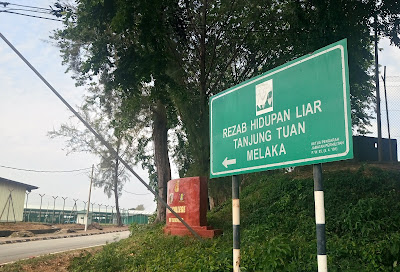I have to start this 6th post of my
1LD1M series with an apology. When I first embarked on this set of travel stories, the intention was to write about a new place in Malaysia that I have never been to before. However, the month of June was mostly taken up by the fasting month of Ramadhan and later the Aidifitri celebration. Hence there wasn't much traveling except for the
balik kampung trip to my better half's hometown of Mersing.
To keep the series in motion, I therefore have to slightly bend my rules and write about Mersing, a place I have written about a few times before. Sorry about that. Nonetheless, I hope the new information I'm sharing here would be helpful to readers who plan to drop by this small town on the east coast of Johor.
While
Mersing is probably more well-known for its beaches (Air Papan, Penyabong etc.) and as the stepping point to the islands (Tioman, Sibu etc.), I'll focus my writing on a few
makan places that are worth mentioning.
1. Nasi Dagang
Not many people know that Mersing has a good selection of food items that originated from Terengganu like
nasi dagang,
keropok lekor and
satar. This is because a sizeable number of Terengganu descendants have settled there, especially in the area known as Mersing Kanan (locally known as Tanjung). Perhaps the most famous of all the nasi dagang in Mersing is
Nasi Dagang Mak Yah, sold from a simple stall next to the main wet market. The nasi dagang is so popular that you have to queue to buy it.
However, Mak Yah sells her nasi dagang for take-away only. If you wish to have your nasi dagang as a sit-down breakfast meal or not patient enough to stand in a waiting queue, I recommend you make a visit to
Nasi Dagang Warisan Kak Ju. It is a foodstall located on Jalan Makam, a road that runs along the coast on the north side of town. Other than nasi dagang, Kak Ju also sells nasi lemak, nasi minyak and other breakfast items. Although it is slightly out of town, the short drive would be worth it. Taste is good, price is very reasonable (still at kampung levels) and parking space is ample.
 |
| Warisan Kak Ju. Visited 28 June 2017 |
 |
| Nasi dagang on a plate |
2. Nasi campur masakan kampung
For a kampung-style
nasi campur (mixed rice) lunch meal, our place of choice is a foodstall called
Kedai Ucu Selera Kita, also located on Jalan Makam but nearer to town. This place sells a wide spread of kampung dishes that would make you spoilt for choice. The slight drawback is that service may be a bit slow when the huge crowd hits at lunchtime. On weekends, hungry out-of-towners would flock the place, so if you wish to avoid it, try coming here before noon. Despite this minor inconvenience, we like to have our lunch here because we've not found another place in Mersing which can match the variety of dishes on offer.
 |
| Large seating area that's quickly packed |
 |
| Typical nasi campur mix consisting of asam pedas ikan, sayur and telur asin |
3. Mee bandung
You wouldn't think you'd find good
mee bandung muar in Mersing, would you? I'll tell you now that you can. But you have to drive some ways out of town to reach the place.
Mee Bandung D'gunung is an unimpressive stall located right by the roadside of Federal Route 3 about 10km north of town. If you are driving from Mersing town towards Endau, you'd probably miss it. But if you are game for a bit of difference, then make a look-out for it on your left-hand side after you pass the water treatment plant in Tenglu.
The stall is mostly a one-man show run by an amiable gentleman called Encik Mat. If you come in a large group, then patience is key. He operates from early morning to around 6pm with a short closing period around mid-day for
zohor prayers.
While the mee bandung is not bad, Encik Mat also serves good mee soto too. Again, prices are still customer-friendly.
 |
| Location is just by the main road |
 |
| Mee bandung in reasonable portion |
 |
Couldn't resist a bowl of mee soto after finishing the mee bandung |
4. Satar and keropok lekor
Okay, back to the Terengganu delicacies of
satar and
keropok lekor. There are not that many stalls selling satar. We have tried almost all and the one we consider the best is located near the keropok gallery along Jalan Makam at Mersing Kanan. This stall has no particular name so I decided to give it the title of
Gerai Satar Terbaik Mersing and recommended an addition to Google Maps.
They start business around 11 in the morning and would sometimes be sold-out by 3pm. They have a few small tables where you can sit and have your satar in-situ. Complete your selection with some keropok lekor,
otak-otak,
kuih paung and
cendol which they also sell, and you have a satisfying tea-time meal.
 |
| Satar and otak-otak over charcoal fire |
 |
| Satar is made up of fish, coconut and some killer bits of cili padi |
 |
| Kuih paung whose insides are also fish and coconut |


































